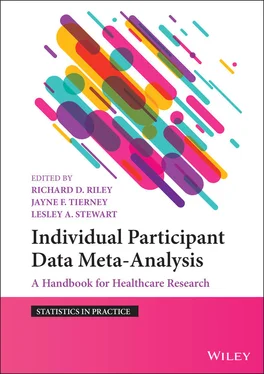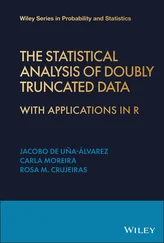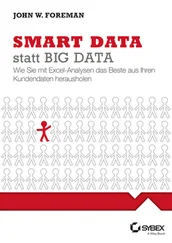1 Individual Participant Data Meta‐Analysis for Healthcare Research
Richard D. Riley, Lesley A. Stewart, and Jayne F. Tierney
Healthcare and clinical decision‐making should be guided by the evidence arising from high‐quality research studies. Often a single study is insufficient to make firm recommendations, and so multiple studies are conducted to address the same research question. This motivates the need for evidence synthesis : the combination of data from multiple studies to provide an overall summary of current knowledge. For example, when multiple randomised trials have examined the effect of a particular treatment, evidence syntheses are needed to combine and summarise the information from these trials, in order to establish whether the treatment is effective or not.
Systematic reviews are the cornerstone of evidence synthesis and evidence‐based decision‐making in healthcare. They use transparent methods to identify, appraise and combine a body of research evidence, with the goal of producing summary results that guide best practices for stakeholders including patients, clinicians, health professionals, and policy‐makers. Systematic review methodology has been championed by organisations such as Cochrane, who publish systematic reviews in the Cochrane Library summarising the effects of interventions, 1the accuracy of diagnostic tests, 2the prognostic effect of particular factors, 3and the performance of risk prediction models. 4Most systematic reviews include a meta‐analysis , 5which is a statistical technique for combining (synthesising) quantitative data obtained from multiple research studies. Traditionally, most meta‐analyses have used aggregate data extracted from study publications, but there is growing demand for meta‐analyses that utilise individual participant data (IPD). 6–9
This book is intended as a comprehensive handbook for healthcare researchers undertaking IPD meta‐analysis projects. In this introductory chapter, we clarify differences between IPD and aggregate data, and outline why IPD meta‐analysis projects are increasingly needed. Then, we detail the scope of our book and its intended audience, and signpost where to find material in subsequent chapters.
1.2 What Is IPD and How Does It Differ from Aggregate Data?
IPD refers to the raw information recorded for each participant in a research study (e.g. a randomised trial), such as baseline characteristics, prognostic factors, treatments received, outcomes and follow‐up details, and can be represented by a dataset containing a separate row per participant and columns containing values for each participant‐level variable. For example, IPD for a randomised trial of anti‐hypertensive treatment will usually include the pre‐ and post‐treatment blood pressure level, a treatment group indicator, important clinical characteristics and prognostic factors recorded at baseline (such as age, sex, BMI and comorbidities), and relevant follow‐up information (such as time to cardiovascular disease or death). An IPD meta‐analysis project, therefore, involves the collection, checking, harmonisation and synthesis of IPD from multiple studies to answer particular research questions. An excerpt of IPD collected from 10 randomised trials for an IPD meta‐analysis project is given in Box 1.1(a), after harmonisation into a single dataset ready for meta‐analysis to summarise the effect of anti‐hypertensive treatment. This dataset contains a single row per participant in every trial.
In contrast, aggregate data refers to information averaged or estimated across all participants in a particular study, such as the treatment effect estimate, the total participants, and the mean age and proportion of males in each treatment group. Such aggregate data are derived from the IPD, and therefore the IPD can be considered the original source material. A conventional meta‐analysis uses aggregate data (e.g. as extracted from study publications), rather than IPD. An example of aggregate data obtained from 10 randomised trials of anti‐hypertensive treatment is shown in Box 1.1(b), after collation into a single dataset ready for meta‐analysis. This dataset contains a single row per trial .
1.3 IPD Meta‐Analysis: A New Era for Evidence Synthesis
“Data sharing is an important part of ensuring trust in research, and it should be the norm.” 10
IPD meta‐analysis projects began to emerge in the late 1980s and early 1990s, 11,12originating mainly in the cancer and cardiovascular disease fields. 13Calls to support IPD meta‐analysis grew strongly throughout the 1990s alongside the formation of methodology working groups, 8,14in particular the Cochrane IPD Meta‐Analysis Methods Group ( https://methods.cochrane.org/ipdma/). 7In the decades since, the number of IPD meta‐analysis projects has risen sharply ( Figure 1.1). Early meta‐analyses based on IPD were commonly described as overviews or pooled analyses, 7,11,15,16until IPD meta‐analysis emerged as the preferred, and now most widely used, label. The IPD abbreviation initially referred to individual patient data , but now individual participant data is the more inclusive and accepted term.
The growth of IPD meta‐analysis projects reflects their potential to revolutionise healthcare research, 14,17especially as they align with three major contemporary initiatives: reducing research waste , 18 data sharing , 19–24and personalised healthcare . 25,26The sharing of IPD maximises the contribution of existing data from millions of research participants, and so is becoming an increasingly frequent stipulation of research funding. Leading medical journals now require data‐sharing statements, with some even enforcing the sharing of IPD on request. 23This has led to dedicated data‐sharing platforms and repositories being established to house IPD from existing studies. 27–31Furthermore, as the drive for personalised healthcare (also known as stratified or precision medicine) continues, 25,26researchers have recognised that, compared to using published aggregate data, IPD allows a more reliable evaluation of how participant‐level characteristics are associated with outcome risk and response to treatment. 32,33Thus, IPD meta‐analysis projects are now central to modern evidence synthesis in healthcare.
1.4 Scope of This Book and Intended Audience
Meta‐Analysis Using Individual Participant Data: A Handbook for Healthcare Research provides a comprehensive introduction to the fundamental principles and methods that healthcare researchers need when considering, conducting or using IPD meta‐analysis projects. Written and edited by researchers with substantial experience in the field, the book details key concepts and practical guidance alongside illustrated examples and summary learning points.
Box 1.1Example of individual participant data (IPD) and how it differs from aggregate data
Illustrative example of 10 randomised trials examining the effect of anti‐hypertensive treatment
(a) IPD
The following table shows hypothetical IPD collected, checked and harmonised from 10 randomised trials examining the effect of anti‐hypertensive treatment versus control in participants with hypertension.
Each row provides the information for each participant in each trial, and each column provides participant‐level information such as baseline characteristics and outcome values.
Only a subset of the IPD is shown for brevity, as in reality many more rows and columns will be needed for each trial, to include all available participants and variables.Trial IDParticipant IDTreatment group,1 = treatment0 = controlAge(years)SBP before treatment(mmHg)SBP at 1 year(mmHg)1114613711112135143133(other rows for trial 1 omitted for brevity)114540622092192105517015522138144139(other rows for trial 2 omitted for brevity)2337144153129(rows for trials 3 to 9 omitted for brevity)101071149128102159168169(other rows for trial 10 omitted for brevity)104695063174128
Читать дальше












